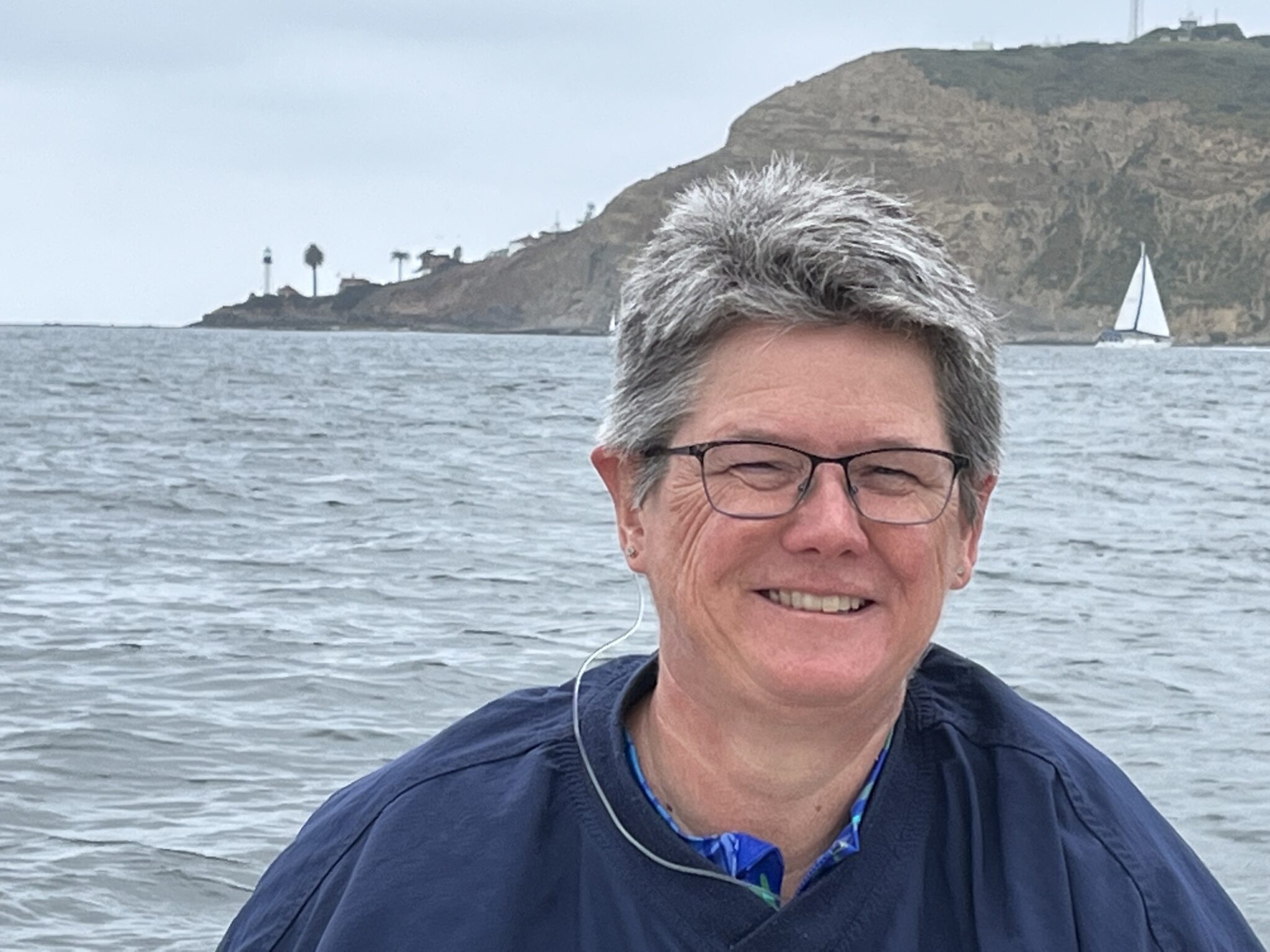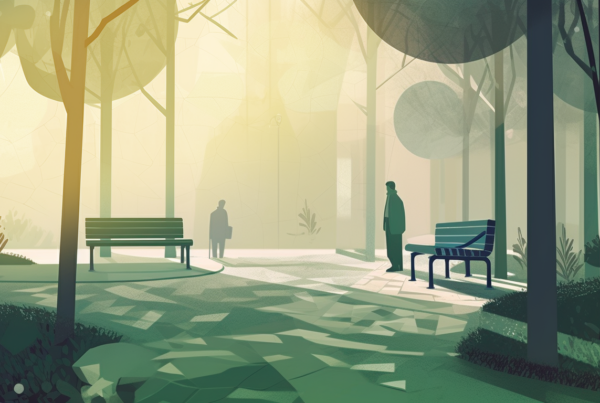I pursued cochlear implant surgery so that I could hear better after decades of significant and progressive hearing loss. The bumpy recovery led to a surprise gap year as an adult, which has been both full of challenges and layered with opportunities.
Why I decided to have cochlear implant surgery
I’ve worked as a full-time chaplain in healthcare for 30 years, and for the most part I have managed doing that work well, even though I have lived with significant and progressive hearing loss since I was a toddler. I developed adaptive skills and tools to get me through life, both as a hard-of-hearing kid and as an adult, but the COVID-19 pandemic amplified my challenges. With everyone required to wear facemasks, I was having even more difficulty than usual understanding conversations well. Facemasks distort speech and block the ability to speech-read (a more comprehensive form of lip-reading that includes facial expressions). In the fast-paced environment of intensive care and trauma care, I needed to hear what family members and staff were saying. I was missing a lot. I was frustrated. I felt I couldn’t maintain a non-anxious presence because I could not hear well.
If I were to continue working in the fast and intense world of hospital emergencies and crisis, I decided I needed to proceed with cochlear implant surgery in order to function well. A cochlear implant had been under consideration even before the pandemic, before the singular focus became just getting through each day during years of lockdown protocols.
I reflected on what I needed. I needed to hear better. I needed to hear more easily so that I wasn’t frayed to my last nerve at the end of the day (listening well in the context of emergencies requires such effort that it siphons off a great deal of energy). To listen attentively when I knew I was not hearing well compounded the stress I felt, especially given the increased hostility toward healthcare workers. Needing to carefully don and doff PPE correctly—so as not to send my two hearing devices or glasses flying—compounded my weariness. A break in this schedule was welcome, even if it was because of surgery.
Making plans for my cochlear implant surgery recovery
Like most anticipated surgeries, I knew this would require planning for time off and recovery. The surgeon told me to double the amount of time I thought I’d need, so I arranged to take a medical leave for three months. With that amount of time off, I planned several projects: clean and organize the garage, get fit with bike rides and walks with the dog, plant my garden, sort through stuff in the junk room, and schedule a couple of adventures.
I began to think of this downtime as a sabbatical. I warned people that I was likely to be anti-social, since the surgery would take away what little hearing I had left in one ear. I tried to prepare myself, my family, my friends, and church people that I was not going to talk to them much.
Related: Sabbatical resources for ministers
Thanks to a grant through my denomination, the Reformed Church in America, I planned to be deliberate in this three-month quiet time. First, I was going to retreat for several days at an Episcopal monastery in our area where I knew the monks and knew the rhythms of their communal worship. The monks had instructions to offer friendly waves, but not to try much conversation with me. Second, my spouse and I were going “up north” (as we say in Michigan) to spend time in nature and walk through the woods and along the beach with our dog. We needed to be away from people; we needed to be in a natural setting to renew our appreciation for beauty in nature. We were going to rest in nature and breathe in some fresh northern air.
My cochlear implant surgery recovery turns into an adult gap year
Once surgery happened, my ideas about quiet, productive time were rudely met with overwhelming vertigo and wildly obnoxious tinnitus, neither of which I had experienced in any remarkable way earlier in life. I needed help getting from my chair to the bathroom; I was awakened to what sounded like civil defense sirens going off in my head. The project list I’d thought would be a welcome way of being productive became instead an insurmountable undertaking. It occurred to me that if the vertigo continued, I might never again be able to ride my bicycle or sail.
I needed to re-learn sounds. I was like a two-year-old, repeatedly asking Terry, my spouse, “What’s that sound?” At one point, I heard the horn of a train a couple miles from our home. I asked Terry if that was the train; he confirmed it was by saying, “Ding, ding, ding!” (That’s become one of our baseline jokes for sounds that Cindi has learned to hear.)
The dog’s toenails on our wood floors are new sounds; hearing the clock tick is new to me, which is still a bit of a wonder.
This was not supposed to be a yearlong project, but it has become one. Three months of medical leave became six months of short-term disability. When my hearing was not sufficiently restored after six months, I went on long-term disability, the duration of which is still unknown. The plans I’d had for quick adaptation to a new hearing device have met some stubborn gaps in my brain’s ability to connect sounds with objects, and connect words with understandable and meaningful words—partly because my brain had not heard or interpreted these sounds for many, many years. The audiologists and aural therapists call these “phonemes,” speech sounds that distinguish one word from another. There are 44 sounds in the English language that blend to form words. Some phonemes are quite like each other, which can make for fun confusion, or frustrating discernment.
These same hearing professionals also note that each person’s adaptation to a cochlear processor is different. I’m not appreciating my uniqueness anymore.
Taking a gap year as an adult
This has been a challenging year, one I’ve begun referring to as my “gap year.” In some ways, it still has elements of a sabbatical: rest, learning, and study. For instance, my gap year has included several different kinds of retreats.
The first retreat was self-directed and mostly solitary, save for the friendly monks. A second retreat was a directed time with a group of women I did not know, except for the leader. I felt my soul restored by the themes and conversations related to life changes. I learned new practices and songs, and I established spirit-affirming relationships with the others in our group, as well as in the monastic community where the group stayed. I knew I couldn’t get the pitch or tone of the new songs right away (as cochlear processors are known not to process music well), but I could find them on YouTube to learn them and be reminded of this communion of women saints who shared their lives and resilient faith. The echoes of our singing and continued FaceBook glimpses are ties to a lasting strand of spiritual connection from that retreat.
I’ve engaged in some community projects this year that otherwise would have been ruled out by my schedule. I participated in a county advisory council on health inequities that included conversations that highlighted several churches’ programs in such a positive way that I had to tell the group that I was not accustomed to people speaking so well of the church! I also attended some of my own congregation’s daytime programs, including funerals of long-time members. I am next looking at a stack of books I’m reading in preparation for a weeklong seminar on African American autobiographies, drawing from these readings and discussions for implications for worship and pastoral leadership.
I picked up a book I’d set aside some years before, Braiding Sweetgrass. I chose this book because I had it on hand and because I could listen to the author read it. This was a very long and tedious process—not only listening to a book for many, many hours, but trying to connect the author’s voice reading the words and my understanding the words. It was like learning to read again: sounding out words like a kindergartener, making sure I heard it right or replaying portions to catch what was said. I was working to combine the technology of my highly technological implant with my brain’s ability to interpret words and recognize noises as identifiable sounds.
Reading and hearing Robin Wall Kimmerer’s book was a long lesson in connecting with the natural world. Her respect for the natural world and descriptions of plants and ecology stirs one to awe. Behold: a plant is not just a plant; it has a relationship with other plants, and even with us. When the words connect with comprehension and sounds make sense, I could express “aha” and wonder.
I’ve also started using the Merlin Bird App. I set up my phone to “hear” sounds that Merlin interpreted as specific birds! I could see that there were all manner of birds talking to me, whether I could actually see the birds. I’d show the birds recorded on my app to others; we shared the amazement of this bird tracker. Even so, I also learned that a bird app does not tell me when a tree frog’s sounds or a squirrel’s chatter is distinct from the birds I could hear. But I heard them!
Using this vital, brilliant technology and making sense of it, and connecting to the natural world, is something like catching on to the work of God’s Spirit. We often see it in retrospect when we reflect on how providentially we were cared for in a challenging time, or when we saw how some things worked together for good after all.
What I’m learning in my adult gap year
For many young adults, a gap year is often a time to travel, explore the world, and enjoy some freedom before buckling down into a career and rigid work schedule. My gap year has been a time of finding and learning new things after 30+ years of working in healthcare, with rigid work schedules and expectations that often conflicted with values about spiritual care, health, and self-care. My gap year, a sabbatical of sorts, has been such a freeing time to decide how I wanted to be and how I would sense new directions in vocation. My conclusions are not entirely clear, in case you’re thinking there’s a tidy ending to this. I’m still making my way or, perhaps, more appropriately, trying to discern the way I might best serve in ministry and in my communities.
I have been living in the gap between having anticipated a renewed engagement with full-time ministry, and the current reality of balancing rehabilitation and hearing fatigue with the work and activities I engage. This time of living in that gap has been like living into the unknown. This was unexpected, which doesn’t seem to fit the usual sabbatical mindset of planning for specific goals and activities while trying to rest from one’s normal pace. It’s probably a truer reflection of most of our lives: so much is unexpected. Many people experience dramatic shifts in their lives. I think of the way we try to prepare potential living organ donors, telling them that the process takes time. Unexpected things arise, from incidental medical findings to life circumstances that change. Like much of life, this is nothing like the medical shows on TV where messy matters are resolved in short order and everything falls into place. “Falling into place” can look very different from the script we had in mind.
I had significant concerns about things not progressing quickly last summer. Once I surrendered the sense of making things fit my timeline, I could more readily embrace that this gap year was a time of openness. Openness can be a freedom, knowing that freedom can juxtapose exhilaration and fear. There were several providential factors I learned I could rely on, from financial considerations to the support of my spouse to my own professional identity. I resonate with this line from Teilhard deChardin: “Trust in the slow work of God.” Honestly, I do trust in the slow work of God—I don’t have much of a choice! I can trust in the slow work of God because I have the support of my communion of saints who encourage me. Like freedom’s juxtaposition, though, I also want to be productive and move things along, like picking up the turtle and “helping” it get somewhere faster.
I have long been wary of the sense of Christian triumphalism that sees each hardship as a way for God’s power to shine even brighter. Such triumphalism denies the gut-punch of disappointment, sadness, and hardship. Trusting in the slow work of God means not hop-scotching over the pain, much as we’d like to. The slow work of God means asking, time and again, “What’s that sound?” so that the sound and recognition come together.
As I learned how to recognize certain birds, I realized that the delight of knowing specific birds’ songs was like joining a creation-wide chorus of praise, and could parallel Scripture. Hearing a song sparrow or cardinal was like calling to mind the words of Psalm 24, “The earth is the Lord’s, and all that is in it, the world, and those who live in it.” Of course, this also means hearing the crows and bluejays as part of the chorus, too.
The sounds I hear now—our dog Dexter’s toenails on our hardwood floors, audio books, bird songs from crows and cardinals alike—summon me to join the chorus of praise to God who is purposely working out something.
My “rearview mirror” of the past year brings into focus the feeling of support that comes from belonging to a beloved faith community. I have been privileged to engage in some meaningful work. I have friends and family who inquire about my freedom and responsibilities and progress. I have kind and patient professionals who continue to check on my hearing devices and adaptation with wisdom and hope as we work together to recognize sounds and speech more easily. This has been a very slow work, a work of wondering where and how things will come together. It’s like pondering on a Sunday afternoon: how will the week ahead unfold? What is God up to that I learn, or see, or hear?

Cindi Veldheer DeYoung
Cindi Veldheer DeYoung serves as the independent living donor advocate for the Corewell Health Living Donor Transplant program, and as an on-call chaplain at Holland Hospital. Cindi has served as a healthcare chaplain for over 30 years, having worked in a psychiatric hospital, long-term care facilities, hospice, and intensive care settings. She has served as an elder at Hope Church in Holland, Michigan, and on the RCA’s General Synod Council. Cindi has a particular interest in living and deceased organ transplantation, in addition to sailing and gardening. Cindi is married to Terry DeYoung, who very recently retired as the Reformed Church's Disability Concerns coordinator. Cindi and Terry share their home and life with Dexter, a Brittany spaniel.



